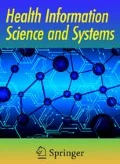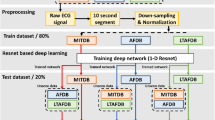Abstract
Atrial fibrillation (AF) is an irregular and rapid heart rate that can increase the risk of various heart-related complications, such as the stroke and the heart failure. Electrocardiography (ECG) is widely used to monitor the health of heart disease patients. It can dramatically improve the health and the survival rate of heart disease patients by accurately predicting the AFs in an ECG. Most of the existing researches focus on the AF detection, but few of them explore the AF prediction. In this paper, we develop a recurrent neural network (RNN) composed of stacked LSTMs for AF prediction, which called SLAP. This model can effectively avoid the gradient explosion and gradient explosion of ordinary RNN and learn the features better. We conduct comprehensive experiments based on two public datasets. Our experiment results show 92% accuracy and 92% f-score of the AF prediction, which are better than the state-of-the-art AF detection architectures like the RNN and the LSTM.








Similar content being viewed by others
Notes
Long-term AF database and AF terminal challenge database is available on:https://physionet.org/.
Tenorflow’s programs can be accelerated using NVIDIA GPU drivers, the driver is available on: https://developer.nvidia.com/cudnn.
References
Yuan C, Yan Y, Zhou L, Bai J, Wang L. Automated atrial fibrillation detection based on deep learning network. In: 2016 IEEE international conference on information and automation. 2016. pp. 1159–64.
Arruda M, Natale A. Ablation of permanent AF. J Interv Cardiac Electrophysiol. 2008;23(1):51–7.
Callahan T, Baranowski B. Managing newly diagnosed atrial fibrillation: rate, rhythm, and risk. Cleve Clin J Med. 2011;78(4):258–64.
Rieta JJ, Zarzoso V, Millet-Roig J, García-Civera R, Ruiz-Granell R. Atrial activity extraction based on blind source separation as an alternative to QRST cancellation for atrial fibrillation analysis. Comput Cardiol. 2000;2000:69–72.
Lu Xilie, Tan Xuerui, and Xu Yong. ECG analysis of atrial fibrillation. People’s Publishing House 2011.
Sinha AM, Diener HC, Morillo CA, Sanna T, Bernstein RA, Di Lazzaro V, Brachmann J. Cryptogenic stroke and underlying atrial fibrillation (CRYSTAL AF): design and rationale. Am Heart J. 2010;160(1):36–41.
Häußinger K, Stanzel F, Huber RM, Pichler J, Stepp H. Autofluorescence detection of bronchial tumors with the D-Light/AF. Diagn Ther Endosc. 1999;5(2):105–12.
Thijs VN, Brachmann J, Morillo CA, Passman RS, Sanna T, Bernstein RA, Rogers TB. Predictors for atrial fibrillation detection after cryptogenic stroke: results from CRYSTAL AF. Neurology. 2016;86(3):261–9.
Chauhan S, Vig L. Anomaly detection in ECG time signals via deep long short-term memory networks. In: 2015 IEEE international conference on data science and advanced analytics. 2015. pp. 1–7.
Xiong Z, Stiles MK, Zhao J. Robust ECG signal classification for detection of atrial fibrillation using a novel neural network. In: 2017 computing in cardiology. 2017. pp. 1–4.
Shashikumar SP, Shah AJ, Li Q, Clifford GD, Nemati S. A deep learning approach to monitoring and detecting atrial fibrillation using wearable technology. In: 2017 IEEE EMBS international conference on biomedical & health informatics. 2017. pp. 141–44.
Malhotra P, Vig L, Shroff G, Agarwal P. Long short term memory networks for anomaly detection in time series, Vol. 89. Presses universitaires de Louvain. 2015.
Krause B, Lu L, Murray I, Renals S. Multiplicative LSTM for sequence modelling. ArXiv preprint arXiv:1609.07959 (2016).
Hochreiter S, Schmidhuber J. Long short-term memory. Neural Comput. 1997;9(8):1735–80.
Cheng M, Xu Q, Lv J, Liu W, Li Q, Wang J. MS-LSTM A multi-scale LSTM model for BGP anomaly detection. In: 2016 IEEE 24th international conference on network protocols. 2016. pp. 1–6.
Rai HM, Trivedi A, Shukla S. ECG signal processing for abnormalities detection using multi-resolution wavelet transform and Artificial Neural Network classifier. Measurement. 2013;46(9):3238–46.
Hundman K, Constantinou V, Laporte C, Colwell I, Soderstrom T. Detecting spacecraft anomalies using lstms and nonparametric dynamic thresholding. In: 24th ACM SIGKDD international conference on knowledge discovery & data mining. 2015. pp. 387–95.
Li H, Wang Y, Wang H, Zhou B. Multi-window based ensemble learning for classification of imbalanced streaming data. World Wide Web. 2017;20(6):1507–25.
Funding
This work is supported by the National Natural Science Foundation of China (Grant No. 61702274) and the Natural Science Foundation of Jiangsu Province (Grant No. BK20170958), and PAPD.
Author information
Authors and Affiliations
Corresponding author
Additional information
Publisher's Note
Springer Nature remains neutral with regard to jurisdictional claims in published maps and institutional affiliations.
Rights and permissions
About this article
Cite this article
Sun, L., Wang, Y., He, J. et al. A stacked LSTM for atrial fibrillation prediction based on multivariate ECGs. Health Inf Sci Syst 8, 19 (2020). https://doi.org/10.1007/s13755-020-00103-x
Received:
Accepted:
Published:
DOI: https://doi.org/10.1007/s13755-020-00103-x




